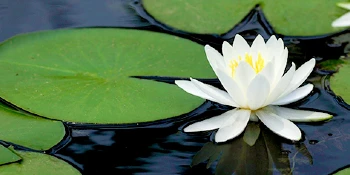The Grounds Guys guide you through building a backyard pond with these steps.
|
A backyard water feature brings you one step closer to nature, and there is no better way to incorporate water into your landscape than with a backyard pond. With endless design possibilities, you can create a one-of-a-kind oasis that your whole family will enjoy. If you're wondering how to make your own pond, the experts at The Grounds Guys have you covered, with tips and techniques to help turn your dream of relaxing beside your own vibrant, self-contained ecosystem into reality.

You Will Need:
- EPDM pond liner
- Filter
- Submersible pump
- Rocks and pebbles
- Underlayment
- Skimmer
- Water plants
- Waterfall tank
- Koi fish
Choose Your Location
Once you've decided to build your own pond, choose the location based on the following:
- Sunlight: It's not necessary to have your pond in a sunny location, but it will increase your options for plant life if there are at least six hours of sunlight each day.
- Power source: The pump and filter run on electricity so choose a spot that is a reasonable distance from a source of power.
- Surroundings: For ease of maintenance pick a location that allows you to access the pond from all sides with room to move, and far enough away from falling leaves which can clog your filter.
- Underground pipes or cables: Check with your local utilities to ensure you are not building (and digging!) your pond over buried lines or cables.
Pick Your Size
How big do you want your pond to be? Do you want a water garden or koi pond? Will you be adding a waterfall or fountain? A water garden requires a depth of 18 inches or more, while a koi pond’s depth needs to be a minimum of three feet.
Choose Your Shape
Before you begin digging, verify the location of electric and gas lines to ensure your safety. Once they are properly marked, use spray paint to outline the shape of your pond, using a level to ensure all sides are even. If a waterfall is in your plans, build up the elevation at the desired end, cascading downwards in accordance with your design.
Start Digging
Small ponds may be excavated by hand, but for larger ponds, professional assistance and equipment may be required. Consider adding “shelves” along sides to add dimension and different types of pond plants. Once digging is completed, line the hole with sand and rake it smooth, before laying down the underlayment which provides a cushion for the EPDM liner.
Insert Your Liner
Insert the liner with the smooth side facing down and the textured side facing up, making sure the liner extends into each corner and crevice. Smooth the liner to prevent any creases while ensuring a loose fit and anchor it in place with stones.
Install Your Equipment
Install the water pump, filter, and skimmer. To ensure the safe operation of electrical equipment surrounded by water, it's imperative that you hire a licensed electrician to install a dedicated outdoor outlet if you don't already have one, that is GFCI-protected. Fill in the bottom of the pond with rocks, boulders, and gravel, being careful not to tear the liner.
Add Water
Fill the pond with water to the desired level. Add a de-chlorinating agent to the water to remove any residual chemicals and allow to sit for 24 hours. Make sure to follow the label directions of any chemical used in the pond to prevent harm the fish or plants.
Accessorize
Add aquatic plants to your pond and wait at least two weeks for nutrient cycles to begin before adding fish.
Your new backyard pond will increase the value and curb appeal of your home while providing you with hours of relaxation and entertainment. For help with this, and other landscaping projects around your home contact the experts at The Grounds Guys today.
For Further Reading
10 Most Amazing Backyard Ponds